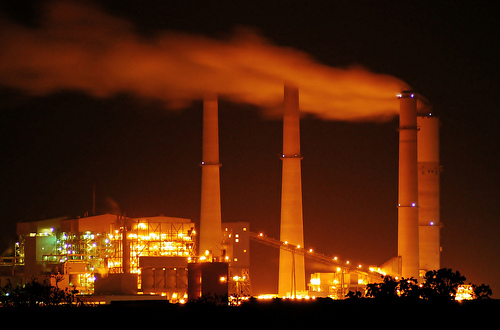

Photo by hsld/Flickr/Creative Commons License
Coal plants are the No. 1 source of carbon-dioxide emissions and one of the largest contributors to climate change. In addition to harming the planet, coal plants release toxins like mercury, arsenic, chromium and acid gases.
Coal-fired plants are responsible for more than half of the human-caused mercury emissions in the U.S. Exposure to mercury can cause neurological impairment, tremors, neuromuscular changes, headaches, kidney failure and other harmful effects on human health. According to the Union of Concerned Scientists, just 1/70 of a teaspoon of mercury deposited into a 25-acre lake would be enough to make the fish unsafe to eat.
The good news is that thanks to more stringent state and federal environmental standards, mercury emissions have declined by about 40 percent over the past decade, according to the Environmental Integrity Project (EIP), a nonprofit organization established by former U.S. Environmental Protection Agency (EPA) enforcement attorneys. However, there are many power plants that continue to emit harmful pollutants.
Here are the top 10 sources of power-plant mercury emissions in the U.S., according to the EIP:
- Martin Lake Steam Electric Station & Lignite Mine (Luminant Generation); Rusk County, Texas
- Gaston Steam Plant (Southern Co.); Shelby County, Ala.
- Big Brown Steam Electric Station & Lignite Mine (Luminant Generation); Freestone County, Texas
- Monticello Steam Electric Station & Lignite Mine (Luminant Generation); Titus County, Texas
- Sandow Steam Electric Station (Luminant Generation); Milam County, Texas
- Coal Creek Station (Great River Energy); McLean County, N.D.
- Ameren Missouri Labadie Energy Center (Ameren Corp.); Franklin County, Mo.
- Grand River Coal-Fired Complex (Grand River Dam Authority); Mayes County, Okla.
- Detroit Edison Monroe Power Plant (DTE Energy Co.); Monroe County, Mich.
- H.W. Pirkey Power Plant (American Electric Power); Harrison County, Texas
But it's not just the mercury that is cause for concern: Power plants are the largest industrial source of arsenic emissions, and the second-largest source of chromium, lead and nickel emissions. These toxic metals have been linked to cancer, gastrointestinal problems, and liver and kidney damage. The EIP ranked the nation's power plants according to their emissions of carcinogenic metals. Here are the top 10 offenders:
- JH Campbell (Consumers Energy); Ottawa County, Mich.
- Laramie River Station (Basin Electric); Platte County, Wyo.
- Paradise Fossil Plant (Tennessee Valley Authority); Muhlenberg County, Ky.
- Conesville Plant (American Electric Power); Coshocton County, Ohio
- Bruce Mansfield Power Plant (First Energy Generation Corp.); Beaver County, Pa.
- Milton Young Station (Minnkota Power Cooperative); Oliver County, N.D.
- AES Puerto Rico (AES Corp.); Guayama County, Puerto Rico
- EME Homer City Generation (Edison International); Indiana County, Pa.
- Brunner Island Steam Electric Station (PPL Corp.); York County, Pa.
- Ghent Station (PPL Corp.); Carroll County, Ky.
Power plants also emit acid gases like sulfur dioxide, hydrochloric acid and hydrogen cyanide, which contribute to chronic respiratory problems like asthma, bronchitis and even lung damage. Here are the top 10 largest power-plant sources of acid gases:
- Big Sandy Plant (American Electric Power); Lawrence County, Ky.
- Monroe Power Plant (DTE Energy); Monroe County, Mich.
- Muskingum River Plant (American Electric Power); Washington County, Ohio
- Mississippi Power Co. - Plant Watson (Southern Co.); Harrison County, Miss.
- Branch Steam Electric Generating Plant (Southern Co.); Putnam County, Ga.
- Cardinal Plant (American Electric Power); Jefferson County, Ohio
- Yates Steam Electric Generation Plant (Southern Co.); Coweta County, Ga.
- EME Homer City Generation LP (Edison International); Indiana County, Pa.
- Clifty Creek Station (Ohio Valley Electric Corp.); Jefferson County, Ind.
- Crystal River Energy Complex (Progress Energy Inc.); Citrus County, Fla.
The good news is that the EPA is working to limit these harmful power-plant emissions and will impose stricter standards on toxic air pollutants. However, there is still work to be done: The EPA's standards only apply to new power plants that are built -- not existing ones -- so that doesn't do anything to mitigate the damage from the power plants listed above.